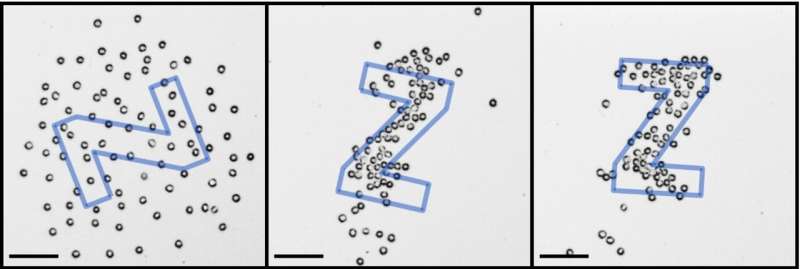Mimicking how water and wind create complex shapes in nature

Intricate natural formations like star-shaped sand dunes or arc-shaped rocks can appear so purposeful in form that it's easy to wonder whether someone has designed them. Scientists have long recognized that a particular combination of random and chaotic energy fields can, over a long period of time, give rise to these kinds of unique formations that dot our globe. Few, however, have succeeded in replicating these natural phenomena.
Researchers at Finland's Aalto University have now found a way to mimic the natural processes that create complex shapes and landscapes with the help of a vibrating plate and resulting energy fields. The results are published on 22 September 2021 in Science Advances.
To create the effect, the team distributed up to 100 particles of tiny metal balls—like those used commonly in soldering—onto a silicon plate measuring 5x5 cm. A camera and smart algorithm allowed the team to track and manipulate the particles into desired shapes, like letters of the alphabet, as the plate vibrated, creating nonlinear energy fields.
"We used the camera to determine the location of the particles, and the algorithm selected the most appropriate vibration frequency to move the particles in the desired direction. The particles move across the plate in a particular direction depending on the vibration frequency, and the same frequency can cause very different directions of movement in different parts of the plate," explains Professor Quan Zhou, who leads the research group behind the findings.
The researchers were surprised at how well the smart algorithm was able to predict the movement of the particles at different frequencies, despite the complexity of their movement. The algorithm efficiently minimized the difference between the target shape and actual particle distribution on the plate.
"The movement of the particle swarm is similar to natural phenomena in which natural materials are shaped by the power of wind and water. The method should work at both smaller and larger scales, and could have many future applications where using hands or tools is difficult," says Doctoral Candidate Artur Kopitca.
Typically, manufacturing a product with a particular shape requires a mold or a pair of skilled hands. The researchers believe that their method inspired by nature could be used to sort cells in medical and bioscience research or as an industrial production method.
A key question that remains open, however, is how many particles can be controlled and how the process can be integrated with other systems which have similar dynamic properties, such as turbulent flows.
Professor Zhou's research group has previously studied the properties of vibrating plates and how they can be used to guide particles along a particular route or towards an end destination. This is the first time that they have attempted to create shapes by mimicking natural phenomena.
More information: Programmable assembly of particles on a Chladni plate, Science Advances (2021). DOI: 10.1126/sciadv.abi7716
Journal information: Science Advances
Provided by Aalto University




















